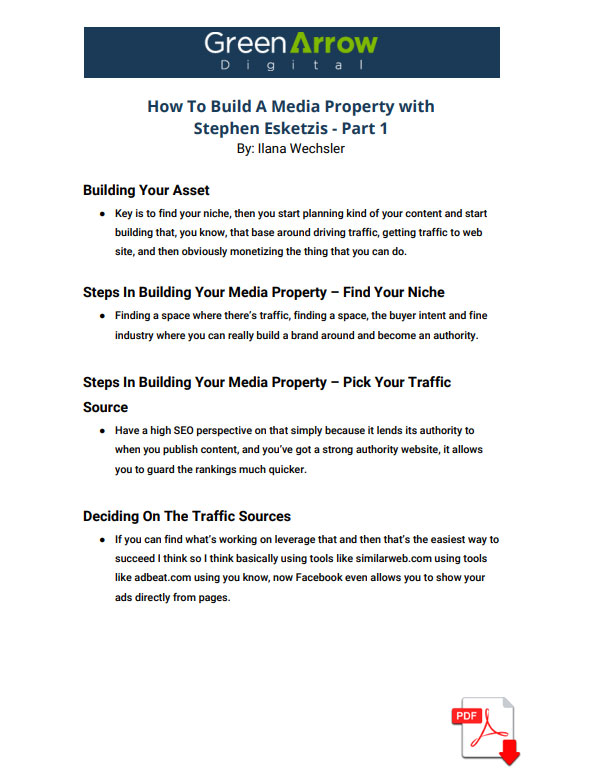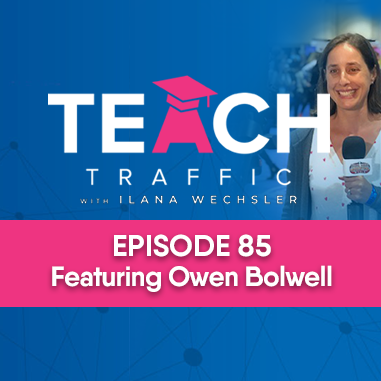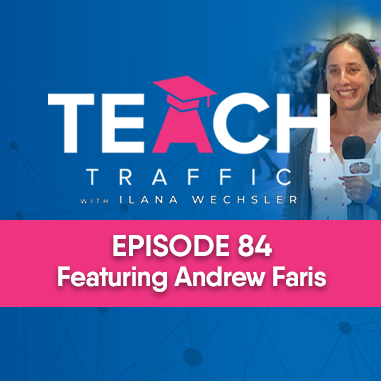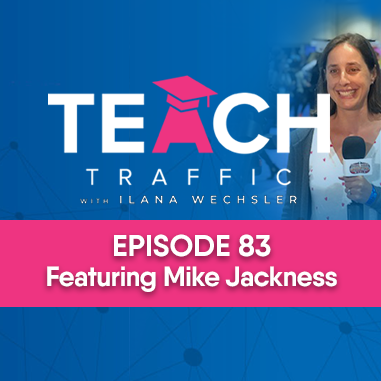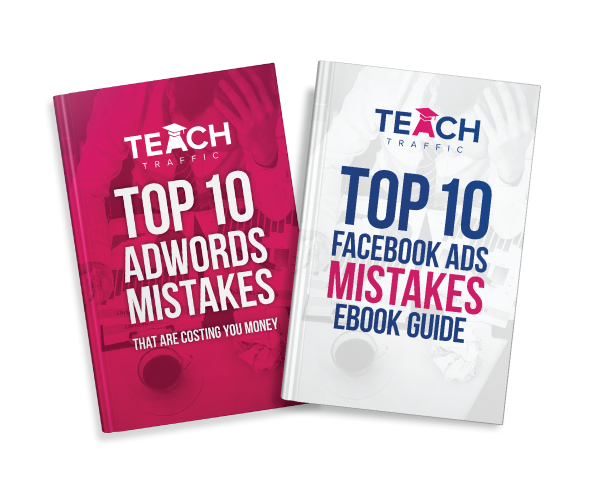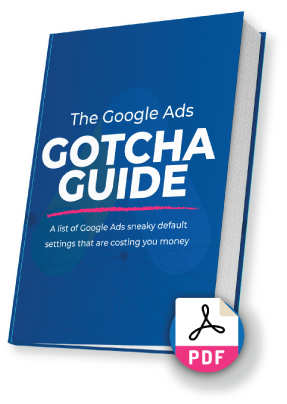34 – How To Build A Media Property with Stephen Esketzis – Part 1
In the podcast:
02:39 – Introduction
10:15 – Building an Asset
12:33 – Steps In Building Your Media Property – Find Your Niche
13:08 – Steps In Building Your Media Property – Pick Your Traffic Source
14:08 – Deciding On The Traffic Sources
15:49 – Benchmarks in Cost Per Clicks
16:54 – Steps In Building Your Media Property – Build Your Content
18:39 – Process In Publishing Content
20:14 – Coming Up With Content Ideas
23:39 – Acquiring Backlinks
Stephen Esketzis built a media web property from 0 to 50,000 daily website visitors in 2 years. He comes on our show to share exactly how he did it and scaled it, and importantly, what he would do differently if he was starting over. This episode is Part 1 of 2
Ilana: Welcome back to another episode of Talking Web Marketing. I’m your host Ilana Wechsler from greenarrowdigital.com. And today I’m interviewing a person called Stephen Esketzis and I recently heard Stephen talk at Traffic and Conversion Down Under. And he’s a very interesting guy. He’s certainly not new to the internet marketing space. He’s been around the traps for a while he’s done lots of interesting and different things which he talks about On today’s episode. But what I actually brought Stephen On today’s episode to talk about is how he built a publishing company or a media property and authority website. He’s been very successful at doing this, he built one of his properties up to a traffic volume of about 50,000 unique visitors per day. So that’s a huge amounts of traffic. And he explains exactly how he did it, the strategy behind it, how being his team was to do so etc. We really break down the whole process of how he did it, and importantly, how you can learn from that and how you could do it yourself. So we actually talked for quite a while, and he shared lots of nuggets of gold. So I had to separate this episode into two parts. So let’s get stuck into part one of a two part episode. So welcome to today’s episode.
Ilana: Stephen Esketzis!
Stephen: Hey, thanks. How’s it going?
Ilana: It’s good. Thank you so much for taking the time out of your busy day to come on my show. I really do appreciate it.
Stephen: No, it’s my pleasure!
Introduction
Ilana: Awesome! So you and I met actually a couple years ago. But we reconnected recently at Digital Marketer down under in the Gold Coast where you did an awesome presentation on marketing hacks and stuff like that. So I thought you would be a fantastic person to interview because you are a wealth of knowledge in the area of, you know, building media properties, and marketing hacks, and funnel hacking, and growth hacking, and all those buzzwords so I thought you could come on today’s show to share your wisdom. So thank you for that. And you kindly obliged, which is very nice of you. But before we kind of get into a lot of the nuts and bolts of this kind of stuff, I’m always interested in people’s story and kind of how you got into the area that you do now. So do you want to maybe briefly talk about your story, and then we can get into the, the meat and potatoes of today?
Stephen: Yeah, definitely. So I’ll give you the kind of quick backstory. Otherwise, we’ll be here all day.
Ilana: How long do you got? (Laughs)
Stephen: Basically. So pretty much finished high-school, did IT University spend one year doing IT ended up transferring to doing commerce. And then when I did commerce, I dropped out of commerce after a year of that and started going into learning funnels. And kind of during that time I was at university, I founded this mobile app, which helped people get into nightclubs quicker. And that was my very first business with an old school friends so founded this app to help people get into nightclubs around Melbourne. It did, okay.
Ilana: Can I ask how you actually, like, get people into nightclubs like, what’s the process like?
Stephen: So the problem I tried to solve a problem. And this was the first problem I face out of high school. So basically was we were waiting in line at clubs and to get in cheaper, you would be on a guest list. So you would have to find someone to guest list to be on or no promoter or something like that. So I was like, well, wouldn’t it be cool to have the promoters on this platform, say, you know, your promoter for you know, this song. So nightclub, you just say, I want James’s list. And then you get a discount. So you don’t actually have to know them, there’s no code, you just have to say their name. But if you don’t know their name, then you don’t get the discount. So what I want to do is get the promoters on this app. So then when I’m going out, I just look up the club, it’ll say the promoters name, and then I get the discount, apparently does that because we’ve got a little bit of traction, you know, probably got about 5-10,000 users on it in Melbourne, which I thought was pretty good.
And then that was just again through like, guerrilla marketing, word of mouth, Facebook posting on your page, nothing ads related at all. And then I ran into, this was going back again, this is probably 2010/2011, I was looking at Gary van der Chuck came on. So there’s this platform called spreecast.com. I don’t even know if it’s around anymore. But it used to be like this live streaming kind of a platform that he was an investor in something. So I was on this platform. I saw him talking. And he was speaking on the platform. And somehow I got on there. And I spoke with him, like one on one about is like, you’re just doing q&a. And he was bringing people up on the screens. I spoke to them one on one isn’t before like, anybody knew about him. And he was back then I was like, so you know, we’ve got this app we’re trying to market What do you recommend, and he said, Facebook ads. And this was like, you know, before I even knew will Facebook ads were so cool like that. And I think they’re called dark posts. And then I was looking at them and he’s like, that’s the way to go. Sounds like cool. Let me look more into that went deeper into the Facebook ad stuff, and then just kind of like immerse myself in the content. So I learned that from there, I learned what a funnel was. From there. I learned, you know, what advertising and you know, all the different offers were and this and that, and I ended up just jumping ship into that industry out of the app and the nightlife space. We did a few more things with the app but yet totally left that and got into digital marketing little data.
And then from there, I kind of just self taught myself everything like, you know, I learned all the content from all the influencers, you know, Ryan Dyess, I feel like Jon Loomer is Facebook stuff I found you know, even what advantage of putting out Russell Brunson and all these guys like to kind of learn more and more. And then at that point, I had a blog, those blogging a bit, you know, just about content marketing, SEO, and Facebook and all that. And then I just started picking up a few clients helping them out with their sales funnel. So it’d be building them their funnels, and, you know, back then it was just again, like, you know, people I’d find in groups and things like that. And I started building these funnels, and then at some point in around that period, click funnel was launched. And I think that was, you know, about three or four years ago now. And I started playing around with Click Funnels, and I was familiar with kind of, a lot of, you know, the tech and knowledge I was kind of knew the industry at the start of that, and I was just blogging about, I was like, this is a really cool software could be really big, like, you know, it’s like that, remember those guru and it’s all internet marketing. He and I started blogging about it, and then I was like, I started using it started building funnels with it. And then Russell and his team reached out to me, cuz they’re like, Hey, we saw, you know, writing stuff on your blog about Click Funnels, we’re looking for content marketer to do all that content, would you be interested? I’m like, yeah, I’m writing about anyway, might as well get paid to do it. And, you know, due to a bigger audience, so I connected with them worked out a deal made sense, and ended up becoming the head of content marketing as a, like a contractor for about three years. Two years, I think it was, kind of fell into that role.
Ilana: You learned a lot on that role?
Stephen: Yeah, so it was really good. I was like, Oh, you know, what, what have I got to lose right now, maybe we’ll do it anyway, because I was doing at that time, I also start to hate client work. Because the whole point is, like you do with the delivery, you go to sell, you know, this, it was just a one man band. So I was like, now there’s gotta be a better way. So I was like, let me just do this, you know, with the content marketing, and it’ll just tell me, you know, kind of scout my knowledge and network and the whole lot. So, and then those two years with, with Russell and his team software to Boise a couple of times, worked with the team and, you know, met the founders. And actually, the very first day I was in their office, they flew me over Neil Patel came in for a consult that day. And it was like a one day consult with Neil on the strategy and everything like that. So that was very cool. So yeah, it was great perks, and you know, Russell’s awesome and so as their team and, you know, use their software. And then towards the end of that period was, you know, after a while, I was like, hey, like, you know, I’m an entrepreneur, I was kind of doing this a lot for experience, and, you know, to help them and knew what I was doing. But I knew at some point, it kind of wasn’t going to be the be all end all.
And so today, so I was like, Look, it’s probably better than I do my own thing. And towards the end of their AWS looking into like building media properties, because I was doing a lot of content marketing, just SEO, I’ve been involved in the past a little bit. So I was like, what is being you know, I really want to build an asset that’s the one thing I learned, like, pretty early on with finals is funnels or, you know, come and go. But assets kind of stay forever. And that’s where the value of these companies is, it’s the asset. So, you know, you can’t really sell a funnel. So let’s say you’ve got a webinar funnel that’s made you a million dollars, or hundred thousand, or whatever it is, what do you do with that webinar follow, you can’t really sell it to somebody else when you’re ready to move on.
So this media property, I was like, you know, this is going to be an asset, which you can sell to someone think about, like, you know, health dot com, or BuzzFeed or all these other big websites. Like if one day these guys want to shut up shop the value still all there. And then the way I kind of say, there’s like an octopus like, you know, you’ve got your media property, which is the head of the octopus, and then you got funnels coming off of which are all the legs because they are driving traffic and driving sales and offers back to that same brand. So that’s kind of how I got into that. And I just kind of learn more and more about that. And I started focusing more on SEO because there’s tons of traffic there and already had my background in paid media and sales funnels. So kind of mixing all that together, it seemed like a perfect storm.
Ilana: Nice. Wow, that is, that’s a lot of background and building up a knowledge base and experience to get where you are today, which each have their role. You know, I mean, I also do an IT degree like you, but I certainly am, didn’t learn about all this digital marketing stuff. So lots of people be I think that, you know, because I did a digital I mean, a, an IT degree equips you for this. But oh, my God, this when I did my IT, they’re going to show my age a little bit, it was before Facebook existed, you know.
How To Build an Asset
Ilana: Anyway, so what I want to talk to you about today, because I’m sure I will, you know, from the sounds of it, you are more than equipped to talk about how you build such an asset that you talked about how you build a real publishing or media property using leveraging content marketing, but lots of other ways. So I thought, you know, I’m a bit of a visual person, and I think it helps see and kind of first understand, like, the helicopter view of it. And my impression of kind of the process and perhaps you can verify this with me is, is kind of like four main stages, or possibly more, depending on how granular you go. But the first aid might be like the research stage where you’re deciding on the nature, the nature of American listeners, then you build it the new scale, and then you monetize it, would you say, from a helicopter view, those are kind of like the broad brush steps to building an asset, like you talked about?
Stephen: Yeah, definitely. So we pretty much hit the nail on the head that’s like, so I built a few. Now, we’d like different industries and different niches, and we built one particular big one in the health space. But I think the only thing that I would do different. So we build this big health one up research is definitely key to find your niche, then you start planning kind of your content and start building that, you know, that base around driving traffic, getting traffic to web site, and then obviously monetizing the thing that you can do, I think first and at the same time, is monetize at the same time you’re building. That’s one thing I didn’t do the first time around. So we’ve had one now they’re held on those talking about we’ve had for two years, and that one’s been growing really well. And we’ve got a few others as well. But that’s a large one. And then one thing we didn’t do there is monetize on the way up. And because we were very well, I decide to be very aggressive with how I was going to grow it, it grew and we had a lot of lost revenue just from not monetizing earlier on when we could have.
Steps In Building Your Media Property – Find Your Niche
Ilana: Maybe touch on the monetize aspect later, which obviously people can do incorporate, but let’s say you’re starting out, like you, you picked in your niche or whatever, and you’re ready to kind of start the planning stage, what’s something that people need to really plan out, or one of the first steps in, in building such a media property.
Stephen: So first steps is really finding your niche. But as simple as it gets, finding a space where there’s traffic, finding a space, the buyer intent and fine industry where you can really build a brand around and become an authority. That’s, that’s all it really is to it.
Ilana: Okay, steps. The next step, though, like, let’s say, You people, most people, businesses are in their industry. So they know the field, they want to build an authority site on what would be the next step for them.
Steps In Building Your Media Property – Pick Your Traffic Source
Stephen: So once you know your field that it’s about your so you, then you start looking at traffic sources as well, I would say. So media properties generally, that I’ve worked with not not only rely on SEO, but you also want to have a high SEO perspective on that simply because it lends its authority to when you publish content, and you’ve got a strong authority website, it allows you to guard the rankings much quicker. So you’ve got that authoritative part of your media property there. However, you can also look at paid so if you’ve got, you know, in an industry where there’s a lot of traffic in that you need to pay for on Facebook, or, you know, Google advertising or whatever it is the that’s another way to build your media property up as well. So the next step, I guess, really is picking a traffic source for your industry.
Deciding On The Traffic Sources
Ilana: Okay, and I guess how would you decide on those traffic sources? Do you kind of look at your competitors and reverse engineer what their traffic sources are? Or do you try and do something different to them? How do you kind of get it get an idea of what would work?
Stephen: So I’m a huge advocate of like spying and getting a lot of intelligence on other people. Yes, like, out of no use, I didn’t know my growth the growth hacks talk and I’ll share a bit more later but basically, if you can find what’s working on leverage that and then that’s the easiest way to succeed I think so I think basically using tools like similarweb.com using tools like adbeat.com using you know, now Facebook even allows you to show your ads directly from pages. So you can kind of get an idea on if pages are showing ads semrush is really good, ahref is really good for keyword looking and, you know, backlinks So between all these tools, like there’s a wealth of knowledge out there that people can use on you know, is their traffic, how much traffic is a qualified, you know, cost per clicks? or How much is it click in that space, all these different things that, you know, kind of add up to showing you how much how big the market is and how big the buyer intent is in that market.
Ilana: Right. Okay. So the the higher the cost per click, in theory, the more buyer intent and more competitive it is Yeah?
Stephen: Yeah. I mean, like, if you’ve got a you can find someone with a lot of volume of keywords, and there’s cost per clicks, and generally higher across the board. It means you got a big market with, you know, a lot of buyers, but if you find something that’s really narrow, and you know, you only find us through a for keywords that might be really expensive cost per click, you might max out that market pretty quick. So it’s just about finding something I think you can grow.
Benchmarks in Cost Per Clicks
Ilana: Yeah, nice. I would think that some listeners would be wondering, what would you consider to be a low cost per click? Or what would be a high cost per click, like some kind of broad rush benchmarks?
Stephen: Yeah, I mean, to be honest, when you’re looking at all this out and running by cost per click, I just look simply by market so for example, like we went into health The reason we went to health was because I was like, You know what, this is gonna be the first kind of project I know other people are already doing well in health because if you go to Clickbank to sell the health supplements and info products, if you, you know, go to Google, you see, everyone has a symptom or problem and they look up before they get better. And we saw the volume, the search volume was just crazy there. So I was like, you know, what takes a lot of boxes, people making money there. And away we went. So it really like I mean, you can put more thought into it. But kind of that as long as you see that there’s buyers in that space, you’re pretty safe. And another way to do it is like Amazon have will get Amazon look at all the different niches within Amazon and then see how many products are listed. See how many reviews are taking place. That’s another way to kind of look, find a niche if you’re struggling as well.
Steps In Building Your Media Property – Build Your Content
Ilana: Yeah, awesome. Alright and here is a kind of way you start really just, I guess, writing the content building out authority posts, I would imagine?
Stephen: Correct, yeah. So then the next step is, obviously you want to build content become an authority. So what we did is I’m a really lazy writer, I’m a writer that Yeah, like when I write it’s probably Golan but when I don’t write, which is 99% of the time, nothing comes out, because I don’t like sitting there and writing. And they usually do one post a year. And that’s like a summary of my year. But aside from that, I really don’t write any content. So you’ll be surprised to know, I haven’t written a word of content on any of the media properties I own which is, which is cool. So what we do is we hire writers, and we’ve got a like a long winded process for that. But we started hiring writers from the US and Canada. And then we expanded hiring rise to the Philippines because it’s a lot cheaper and their English is actually really good.
And then we have now a very stringent process in filtering good writers from bad writers, we put them through tests and hurdles to make sure that the quality is up to standard. And then it’s just about time building like a factory of a writing team. So the way I see it is, if you go to a factory, you know, you’ve got the inputs are going, you got the process the operations to, you know, turn the inputs into a product, and then you got the output. So same with writing where you’ve got the riders are the inputs, they’ll start the content, and then it goes into the editing phase. So it’ll go through one or two rounds of editing. And then once the editing is done, it’ll get passed on to the publishing team. So they’ll format the article published the article, and then it gets syndicated out on your website, on your social media. And away it goes.
Ilana: Wow. So can I ask how many people are involved in the process of publishing an article?
Stephen: Yeah, so I mean, well, you’ve got your writer, then you’ve got your editor. Well, so for us. Anyway, we’ve got a writer than we’ve got an editor, then we’ve got some people who do designs on that article. So we’ll get a custom design made, like a featured image, or in content designs, and we’ll add images, that’s three people. And then after that, it goes into formatting. So it gets published on the website, that’s four people. And then the fifth is syndication and scheduling. So five, five people in the process from start to end.
Process In Publishing Content
Ilana: Awesome! I guess when you sort of starting to build it out, do you adhere to a publishing schedule? Or do you just have to be a publisher as much as you possibly can?
Stephen: In the beginning, I attend to publish as quick as I can, because we want to gain that ranking as close as we can. But the more you publish, and the more content you’ve got coming through, the slower you can go. So we like we didn’t have all these writers, and it’s being team to begin with, we just had a writer. So it was before that it was as a writer, and then me vetting the content, and then sending it back, and I fixing it than me fixing it, and then publishing it. But if you want to just gain that traction, early on, we just published straightaway, to start indexing on Google, because we’re brand new, but if you’re already starting, you’ve got, you know, say, 30-40, 50-60 posts already on the website, then you can start scheduling out, you know, once a day, or, you know, twice a week, or whatever it might be, because Google, I think, like seeing articles come out again, and again. And again, they get used to seeing things published on your website, that means that index you quicker and you know, the relationship between your site and Google is a good one.
Coming Up With Content Ideas
Ilana: Yeah. What are some of the ways that you I guess, come up with new content ideas, I mean, sure, you know, when you’re starting out, you’ll have you can identify your pillow posts and the classic kind of things you got to talk about. But you know, when new publishing every day, I’m sure you’re very quickly run out of ideas. So,
Stephen: I mean, the keyword research phase of that tool, again, tools, the best friend, so ahrefs is really good for this semrush is again, really good for this. So what you want to do is like, let’s say you want to find you want to do an article on health benefits. So we we’ve done heaps of health benefits, if you put in just the word health benefits, it’ll show you all the health benefit types of keywords that are out there. So health benefits of bananas, help with the turmeric, health benefit apples, whatever it might be. So we go through that process of, you know, keyword research, finding broad keywords, the narrowing it down to a second level is like a tier two longtail level and then once we’ve narrowed it down, we then look at the volume of each of those searches. So we’ll look up how many people searching for, you know, health benefits of bananas, is it you know, at a month, 800 a month, 8000 a month, and then we categorize it based on the volume.
So we’ll start looking from most volume to lease volume, and then we’ll start rolling at content for each of those keywords. And then if you’ve you know, you still struggling with content like that, you can go to a website called answerthepublic.com and you put in your top. Yeah, and it generates you tons of questions. And again, do the exact same thing, put them all into like, somewhere, we can find the search volume, so like it was sem rush or whatever, and then ordered by search volume, have a look. And then, you know, it doesn’t have to be by search volume, you could do it by default Keyword Difficulty. So if someone more competitive might take longer to rank, so you might want to leave it to later. But if you’re a big solder ready, and you’ve already got that authority behind you, then you can maybe tackling keyword that’s more competitive.
Ilana: Awesome. I mean, I know a little bit about SEO, I usually say to people enough to be dangerous. So I know that website structure is quite important when you really trying to, I guess, rank a website and generate traffic Do you do I mean, is that right? Like that the structure of your content is important. And I guess, do you decide that in the beginning?
Stephen: Yeah, like, I can tell you pretty much within 20 seconds, what we did that got us to so at right now, like, I think in our peak, the site’s getting about 50,000 uniques a day. So we’re getting a lot of traffic. And to get to that, like, like I said, this was our first site or my first site, you know, there was no like, I thought it was okay to SEO, but I was no expert by any stretch of the imagination. So what we’ve to get from literally zero, so we had no traffic or the way that 50,000 people a day was literally focusing 80%, maybe 70% of our time on acquiring authoritative backlinks. So reaching out to people saying, Have you looked at our content, it’s similar to the content you’re currently linking to replace your link with Allah, or add your link to your article. So that was the first thing we did.
Ilana: That’s one one of the hacks that he shared that the conference was it.
Stephen: Oh, there you go. So there you go. So that was one of the things we’ve done. And we did that just on a really big scale. So we’ve done a lot of that.
Acquiring Backlinks
Ilana: I guess, if, you know, it’s a, you approached me to say, I’m linking to someone a new approach me going, Hey, can you link to me instead? What, like, what’s your motivation for it?
Stephen: We generally test a few different angles. So one thing we’ll do is we’ll offer you know, we might share you on our website, social media, if we’ve got a big following. And other thing is, we might give you a reciprocal link. So he wants to him, we will link back to you as well, another thing could be, we might help promote you to our email list. So it’s generally a matter of finding that mutual value in that offer. And then it just comes down to copywriting. Right. So like, when you’re doing cold email, everything here is appealing to people’s, you know, likes, dislikes, emotions, all that kind of stuff. So then, you know, within this cold emailing link building process, it goes back to the fundamentals of marketing, which is copywriting. So, we literally just start working with different templates and testing headlines and templates and content and angles to see what’s actually going to lead to a better open rate to get people to work with us. So that’s kind of what we do. And then that was one of the campaigns that we did that did quite well. So yeah, I mean, like backlinks is 70%, 60, 70% of the battle.
I’d say 35% is content. So making sure you’ve got really good quality content, long content right now is working really well. So we do articles that no shorter than 2000 words, but on average, reported about five or 6000 word articles. And then on page probably counts about five to 10%, from what I found, I mean, if you if we did, it would probably do even better. But we really haven’t spent that much time doing on page optimization and structures all over the place, that’s something I would recommend doing. I don’t think it’s worth skipping. But we just didn’t spend much time on it on the way up, we just focused on what we were good at. But lately, Google’s rolled out an algorithm which is starting to affect a lot of sites and saying that, you know, they really want to make sure that the authors behind all your content have, you know, legitimate background in the knowledge they’re writing about. So there recently slapped a lot of sites for saying, you know, you might be running all this content, but you know, we’re going to start out ranking people who have proper medical doctorates and things like that, or you have some sort of legitimate experience in the space rather than, you know, say, me writing an article on you know, how to lose weight in 60 days, or something like that, then rather, Google now is done to focus on people who have that experience, who have a PhD or some sort of, you know, experience from university or something like that to to write the article.
So what you’ll start seeing, I think over the next kind of six to 12 months is and we’re also doing this is starting to get people who have that experience to start reviewing a lot of articles by writers to prove that this is good, legitimate back information with someone with experience, we’re just putting, you know, because like if you’re searching for something you know, I’ve done all the time. How do I get rid of a cold in two days then you want to make sure you’re reading something that’s not written by some outsource person who has no experience on the topic and it just ranks well going to make sure the contents good so they really cleaning it up, which is really good to say, Sorry, folks,
Ilana: I have to interrupt the episode there because we had to break up this episode into two parts. So you’ve just finished part one of this episode. Stay tuned for part two and be sure to check out the resource that we will have available for today’s episode at talking web marketing. com. That actually does redirect you to out the podcast section on our website, which you can check out so you can download the show notes and yes, stay tuned for part two.
